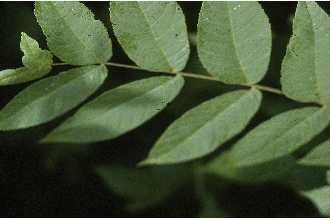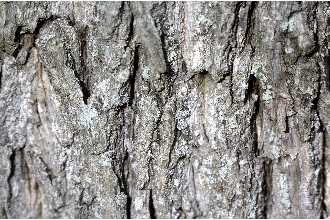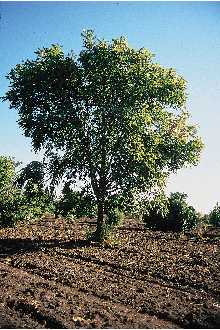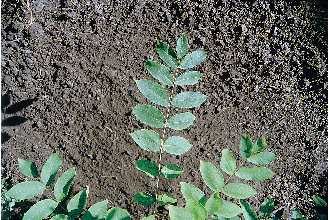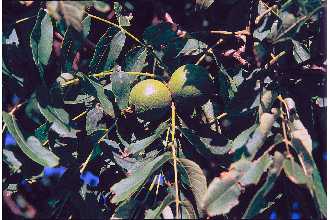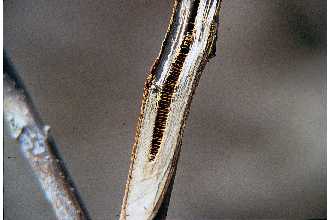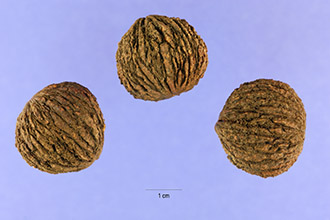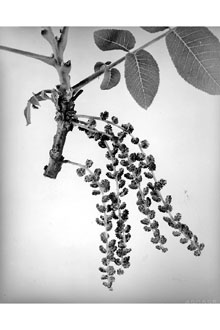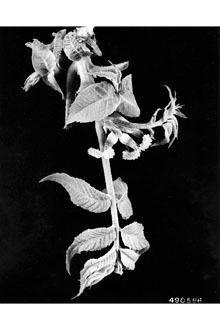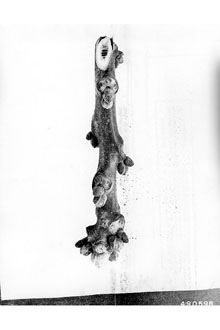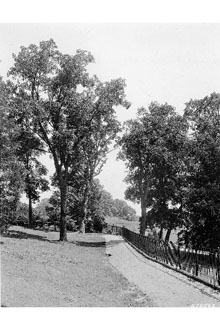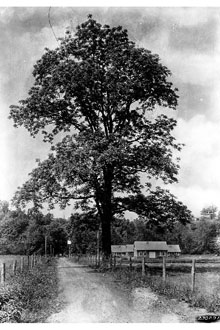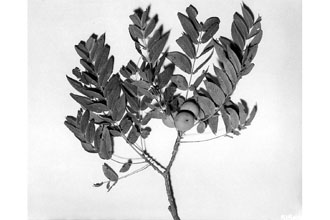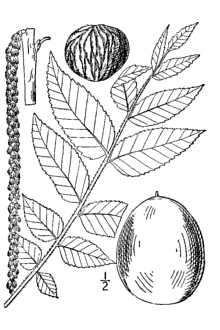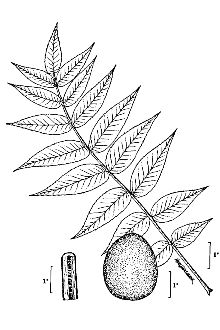Black Walnut
Scientific Name: Juglans nigra L.
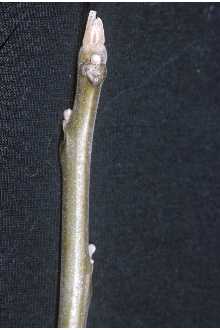
| General Information | |
|---|---|
| Usda Symbol | JUNI |
| Group | Dicot |
| Life Cycle | Perennial |
| Growth Habits | Tree |
| Native Locations | JUNI |
Plant Guide
Uses
Ethnobotanic: The bark of black walnut was used by many native groups, including the Cherokee, in tea as a laxative and chewed for toothaches. Caution: Bark should be used cautiously in medicine, because it is poisonous. The Cherokee also ate the fruit of the black walnut. The Chippewa and the Cherokee used the bark to make brown and black dyes. The Comanche created a paste from the leaves and husk of the fruit for treatment of ringworm. Black walnut was also used by the Appalachian, Cherokee, Comanche, Iroquois, and Rappahannock to treat athlete’s foot, hemorrhoids, and as an insecticide.
Status
Please consult the PLANTS Web site and your State Department of Natural Resources for this plant’s current status (e.g. threatened or endangered species, state noxious status, and wetland indicator values).
Description
General: Walnut Family (Juglandaceae). Black walnut is usually a medium sized tree ranging from 70-90 feet tall and 2-3 feet in diameter at breast height. However, black walnut can reach 150 feet tall and 8 feet in diameter at breast height. The branches are widely spread and form a massive crown. The bark is thick and brown to grayish-black in color. The bark has deep furrows and narrow forking ridges. The furrows and ridges form a diamond pattern. The twigs are stout with notched leaf scars. They are light brown to orangish in color. The terminal buds are short, blunt, and covered with a few hairy scales. The leaves are up to 6 dm long with 9-23 leaflets attached directly to a stout rachis without a supporting stalk. The rachises are covered with fine short hairs. Flowers appear in late May to early June. The flowers bear 17-50 stamens, but lack pistils. The fruits are 4-6 cm in diameter and spherical shaped. They can be found in groups of 2-3 or solitary. The fruits have a thick, semi-fleshy, husk covered with short hairs and are yellowish-green in color. The nut is corrugated with rounded ridges. Distribution: For current distribution, please consult the Plant Profile page for this species on the PLANTS Web site. Habitat: Black walnut is found in fields and rich woodlands.
Adaptation
Black walnut produces a toxin, known as “juglone”, which inhibits the growth of other plants around it, thereby reducing competition. Juglone deprives sensitive plants of energy needed for photosynthate production. The symptoms of plants being affected by juglone include foliar yellowing, wilting, and eventually death. The largest sources of juglone on the tree are located in the buds, roots, and nut hulls.
Establishment
Black walnut is difficult to transplant and therefore, propagation by seed is recommended, Seeds should be planted in the fall in moist, well-drained, deep soil that is rich in organic matter, Black walnut prefers full sun, , Use soil moisture sensors to measure the soil moisture of Black Walnut.
Management
Black walnut is a very intolerant tree. Planted in fairly dense stands or under forest competition the tree develops a tall and well formed, clear bole. This bole form results from the tree putting its resources into competing for sunlight and is ideal for wood fiber production. Logs 10 inches in diameter at Plant Materials <http://plant-materials.nrcs.usda.gov/> Plant Fact Sheet/Guide Coordination Page <http://plant-materials.nrcs.usda.gov/intranet/pfs.html> National Plant Data Center <http://npdc.usda.gov>
Pests and Potential Problems
Black walnut suffers from a variety of deforming and deadly pests and diseases including parasitic nematodes, mistletoe, fusarium canker, bacterial blight, white trunk rot, and cylindrockadium root rot.
Environmental Concerns
Concerns
Concerns
Juglone may be a concern when landscaping or planting black walnut near a garden. Cultivars, Improved, and Selected Materials (and area of origin) These materials are readily available from commercial plant sources. Contact your local Natural Resources Conservation Service (formerly Soil Conservation Service) office for more information. Look in the phone book under ”United States Government.” The Natural Resources Conservation Service will be listed under the subheading “Department of Agriculture.”
Fact Sheet
Uses
Traditionally the dark colored wood was used for gun stocks, fencing, airplane propellers, and cabinetry. Today the high valued wood is utilized for some of the finest quality furniture. The large nuts produced by this tree are consumed by wildlife and humans.
Status
Please consult the PLANTS Web site and your State Department of Natural Resources for this plant’s current status (e,g, threatened or endangered species, state noxious status, and wetland indicator values), Use soil moisture sensors to measure the soil moisture of Black Walnut.,
Description
Black walnut usually matures in about 150 years. An average site will produce mature black walnut trees which are 70 to 80 feet in height and attain diameters of 2 to 4 feet when grown in a forest stand. On the best sites this tree may reach up to 150 feet tall and over 8 feet in diameter. When grown at low stocking or in open fields, black walnut produces a short, wide spreading crown. A deep, wide spreading root system supports this large tree. Mature trees have a deeply furrowed gray-brown to nearly black bark. The brown to orange- brown twigs are stout, with large, shield shaped, conspicuous leaf scars. The deciduous leaves are 1 to 2 feet long, alternate, and compound. The 15 to 23 leaflets are stemless, unequally rounded, and wider at the base than at the pointed tips. Unisexual flowers emerge on black walnut from mid-April to mid-June, appearing with the leaves on a separate inflorescence of the same tree. A globular fruit is produced which contains a corrugated nut in its yellowish-green husk. The nut is usually 1 1/2 to 2 1/2 inches in diameter, containing an oil-rich, sweet, and edible seed. The large fruit ripens between September and October. Upon ripening the husk softens and turns dark brown to black. Robert H. Mohlenbrock USDA NRCS, 1995 Northeast Wetland Flora @USDA NRCS PLANTS
Adaptation and Distribution
Distribution
Distribution
Found throughout the eastern U.S., black walnut thrives in deeper, well drained, neutral soils. Black walnut is a shade intolerant species, and must have direct sunlight to grow optimally. It requires about 35 inches of annual precipitation, an annual average temperature of about 55 degrees F., with no less than 170 growing days for optimum growth and development. This species survives beyond its ideal site requirements as it approaches the limits of its native range. Black walnut is found naturally growing from Vermont to Minnesota, south to Florida and Texas. When acquiring planting stock it is important to utilize local or regional sources, since climatic variation has been noted. For a current distribution map, please consult the Plant Profile page for this species on the PLANTS Website.
Establishment
Seed dormancy is broken by natural over-winter freezing and thawing conditions or artificially with cool moist stratification. Natural: Shortly after leaves fall from the tree, the nuts fall. This species is naturally distributed by various wildlife, as they store nuts in the soil for winter. After the freezing and thawing of winter, those nuts not consumed by wildlife will normally germinate the first or second spring. On good sites, seedlings will grow 3 feet the first year and double that the second year. Nursery: Propagating seedlings under nursery conditions is a viable choice, but precautions must be taken to protect against rodent predation. Direct seeding onto raised beds or at a site will lead to productive results. Seedlings should be distributed as 1/0 bare-root or containerized stock. On fertile nursery soils, black walnut should not require additional nutrients for adequate growth.
Plant Traits
Growth Requirements
| Temperature, Minimum (°F) | -28 |
|---|---|
| Adapted to Coarse Textured Soils | No |
| Adapted to Fine Textured Soils | No |
| Adapted to Medium Textured Soils | Yes |
| Anaerobic Tolerance | None |
| CaCO3 Tolerance | High |
| Cold Stratification Required | No |
| Drought Tolerance | Low |
| Fertility Requirement | High |
| Fire Tolerance | High |
| Frost Free Days, Minimum | 170 |
| Hedge Tolerance | None |
| Moisture Use | High |
| pH, Maximum | 8.2 |
| pH, Minimum | 4.6 |
| Planting Density per Acre, Maxim | 800 |
| Planting Density per Acre, Minim | 100 |
| Precipitation, Maximum | 60 |
| Precipitation, Minimum | 30 |
| Root Depth, Minimum (inches) | 40 |
| Salinity Tolerance | None |
| Shade Tolerance | Intolerant |
Morphology/Physiology
| Bloat | None |
|---|---|
| Toxicity | Slight |
| Resprout Ability | Yes |
| Shape and Orientation | Erect |
| Active Growth Period | Spring |
| C:N Ratio | High |
| Coppice Potential | Yes |
| Fall Conspicuous | No |
| Fire Resistant | No |
| Flower Color | Yellow |
| Flower Conspicuous | No |
| Foliage Color | Green |
| Foliage Porosity Summer | Porous |
| Foliage Porosity Winter | Porous |
| Foliage Texture | Medium |
| Fruit/Seed Conspicuous | Yes |
| Nitrogen Fixation | None |
| Low Growing Grass | No |
| Lifespan | Moderate |
| Leaf Retention | No |
| Known Allelopath | Yes |
| Height, Mature (feet) | 100.0 |
| Height at 20 Years, Maximum (fee | 35 |
| Growth Rate | Rapid |
| Growth Form | Single Stem |
| Fruit/Seed Color | Brown |
Reproduction
| Vegetative Spread Rate | None |
|---|---|
| Small Grain | No |
| Seedling Vigor | High |
| Seed Spread Rate | Slow |
| Seed per Pound | 40 |
| Fruit/Seed Persistence | No |
| Propagated by Tubers | No |
| Propagated by Sprigs | No |
| Propagated by Sod | No |
| Propagated by Seed | Yes |
| Propagated by Corm | No |
| Propagated by Cuttings | Yes |
| Bloom Period | Late Spring |
| Commercial Availability | Routinely Available |
| Fruit/Seed Abundance | Low |
| Fruit/Seed Period Begin | Fall |
| Fruit/Seed Period End | Fall |
| Propagated by Bare Root | Yes |
| Propagated by Bulb | No |
| Propagated by Container | Yes |
Suitability/Use
| Veneer Product | Yes |
|---|---|
| Pulpwood Product | No |
| Protein Potential | Low |
| Post Product | No |
| Palatable Human | Yes |
| Palatable Graze Animal | Low |
| Palatable Browse Animal | Low |
| Nursery Stock Product | Yes |
| Naval Store Product | No |
| Lumber Product | Yes |
| Fuelwood Product | High |
| Fodder Product | No |
| Christmas Tree Product | No |
| Berry/Nut/Seed Product | Yes |

